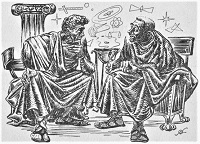
The Dragon of the Ishtar Gate is a historical novel by American writer L. Sprague de Camp, first published in hardcover by Doubleday in 1961, and in paperback by Lancer Books in 1968. The first trade paperback edition was issued by The Donning Company in 1982. The book was reissued with a new introduction by Harry Turtledove as a trade paperback and ebook by Phoenix Pick in September 2013. It is the third of de Camp's historical novels in order of writing, and earliest chronologically. It is set in 466-465 BCE, the last years of the reign of King Xerxes I of Persia.

The Day of the Dinosaur is a science book by L. Sprague de Camp and Catherine Crook de Camp, illustrated with plates. It was first published in hardcover by Doubleday in 1968, and in paperback by Curtis Books in 1970 or 1971. A second hardcover edition was issued by Bonanza Books in 1985. The first chapter was reprinted as "One Day in the Cretaceous" in the de Camps's collection Footprints on Sand.

The Arrows of Hercules is an historical novel by American writer L. Sprague de Camp, first published in hardback by Doubleday in 1965 and in paperback by Curtis Books in 1970. The book was reissued with a new introduction by Harry Turtledove as a trade paperback and ebook by Phoenix Pick in April 2014. It is the fourth of de Camp's historical novels in order of writing, and second chronologically, set in the time of Dionysios I of Syracuse at the end of the 5th and beginning of the 4th centuries BC.

A Gun for Dinosaur and Other Imaginative Tales is a short story collection by American science fiction and fantasy author L. Sprague de Camp, first published in hardback by Doubleday in 1963, and in paperback by Curtis Books in 1969. The first British edition was issued by Remploy in 1974. It has also been translated into German.

The Virgin & the Wheels is a collection of two short science fiction novels by L. Sprague de Camp, published in paperback by Popular Library in 1976. An E-book edition was published by Gollancz's SF Gateway imprint on September 29, 2011 as part of a general release of de Camp's works in electronic form.
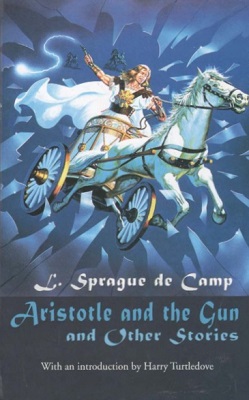
Aristotle and the Gun and Other Stories is a collection of short stories by American science fiction and fantasy author L. Sprague de Camp. It was published in hardcover in August 2002 by the Gale Group as part of its Five Star Speculative Fiction Series.

Years in the Making: the Time-Travel Stories of L. Sprague de Camp is a collection of science fiction stories by American author L. Sprague de Camp, edited by Mark L. Olson and illustrated by Bob Eggleton. It was first published in hardcover by NESFA Press in February 2005, with a NESFA/Science Fiction Book Club edition following in September of the same year.
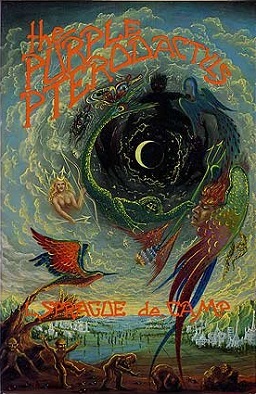
The Purple Pterodactyls is a collection of fantasy short stories by American writer L. Sprague de Camp. The collection was first published in hardcover by Phantasia Press in January, 1980, and in paperback by Ace Books in April of the same year. It has also been translated into German. An e-book edition was published by Gollancz's SF Gateway imprint on September 29, 2011 as part of a general release of de Camp's works in electronic form. The pieces were originally published between 1975 and 1979 in the magazines The Magazine of Fantasy & Science Fiction, Fantastic, Escape!, and Fantasy Crossroads.

Tales from Gavagan's Bar is a collection of fantasy short stories by American writers L. Sprague de Camp and Fletcher Pratt, illustrated by the latter's wife Inga Pratt. It was first published in hardcover by Twayne Publishers in 1953; an expanded edition rearranging the contents and adding pieces not in the first was published in hardcover by Owlswick Press in June 1978. The original illustrations were retained in this edition. It was subsequently issued in paperback by Bantam Books in January 1980. An e-book edition was published by Gollancz's SF Gateway imprint on September 29, 2011 as part of a general release of de Camp's works in electronic form. The collection has also been published in German.

Conan the Barbarian is a 1982 fantasy novel written by L. Sprague de Camp, Lin Carter and Catherine Crook de Camp featuring Robert E. Howard's seminal sword and sorcery hero Conan the Barbarian, a novelization of the feature film of the same name. It was first published in paperback by Bantam Books in May 1982. The first hardcover edition was issued by Robert Hale in 1983, and the first British edition by Sphere Books in April 1988. A later novel with the same title by Michael A. Stackpole was issued by Berkley Books in 2011 as a tie-in with the 2011 remake of the 1982 film.

Conan the Swordsman is a collection of seven fantasy short stories and associated pieces by writers L. Sprague de Camp, Lin Carter and Björn Nyberg featuring Robert E. Howard's sword and sorcery hero Conan the Barbarian. It was first published in paperback by Bantam Books in August 1978, and reprinted in 1981. Later paperback editions were issued by Ace Books. The first hardcover edition was published by Tor Books in December 2002. The first British edition was issued by Sphere Books in 1978. The book has also been translated into Italian and French. It was later gathered together with Conan the Liberator and Conan and the Spider God into the omnibus collection Sagas of Conan.
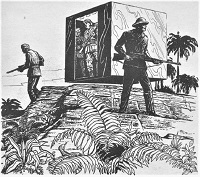
"A Gun for Dinosaur" is a classic time travel science fiction story by American writer L. Sprague de Camp as part of his Rivers of Time series. It tells the story of four men who travel into the past to hunt dinosaurs.

"The Wheels of If" is an alternate history science fiction story by American writer L. Sprague de Camp. It was first published in the magazine Unknown Fantasy Fiction for October, 1940, and first appeared in book form in de Camp's collection The Wheels of If and Other Science Fiction. It later appeared in the paperback edition of the collection published by Berkley Books in 1970, in de Camp's subsequent collections The Virgin & the Wheels and Years in the Making: the Time-Travel Stories of L. Sprague de Camp, and in the anthology Unknown Worlds: Tales from Beyond. It also appeared, together with a sequel by Harry Turtledove, in The Pugnacious Peacemaker/The Wheels of If and Down in the Bottomlands and Other Places. The story has also been translated into German.

"Judgment Day" is an apocalyptic science fiction story by American writer L. Sprague de Camp. It was first published in the magazine Astounding Science Fiction for August, 1955, and first appeared in book form in the anthology The Best Science Fiction Stories and Novels: 1956. It later appeared in the de Camp collections A Gun for Dinosaur and Other Imaginative Tales, and The Best of L. Sprague de Camp, as well as the anthologies Great Science-Fiction, A Science Fiction Argosy, and Masters of Darkness III. The story has also been translated into German.

"The Gnarly Man" is a science fiction story by American writer L. Sprague de Camp, about an apparently immortal Neanderthal Man surviving into the present day.

"Divide and Rule" is a science fiction novella by American writer L. Sprague de Camp. It was first published as a serial in the magazine Unknown from April to May, 1939 and first appeared in book form in de Camp's collection Divide and Rule. The story was revised for book publication. The first stand-alone book edition of the story was published as a large-print hardcover by Thorndike Press in September 2003. An E-book edition of the story was issued by Gollancz's SF Gateway imprint on September 29, 2011 as part of a general release of de Camp's works in electronic form.

"The Hardwood Pile" is a contemporary fantasy story by American writer L. Sprague de Camp. It was first published in the magazine Unknown for September, 1940. It first appeared in book form in the collection The Reluctant Shaman and Other Fantastic Tales ; it later appeared in the collection The Best of L. Sprague de Camp, and the anthology Bestiary! The story has been translated into French and German.
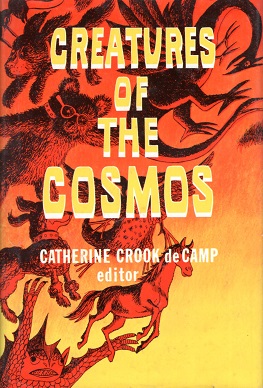
Creatures of the Cosmos is an anthology of fantasy and science fiction short stories for younger readers, edited by Catherine Crook de Camp. It was first published in hardcover by Westminster Press in 1977. It was the third such anthology assembled by de Camp, following the earlier 3000 Years of Fantasy and Science Fiction (1972) and Tales Beyond Time (1973), both of which she edited together with her husband L. Sprague de Camp.

"In-Group" is a science fiction short story by L. Sprague de Camp. It was first published in the magazine Marvel Science Fiction for May, 1952. and later reprinted in the magazine Skyworlds for February 1978. It first appeared in book form in the collection A Gun for Dinosaur and Other Imaginative Tales. The story has been translated into Italian and German.
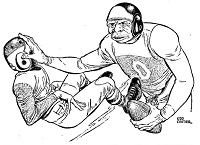
"Throwback" is a classic science fiction short story featuring atavism by L. Sprague de Camp. It was first published in the magazine Astounding Science Fiction for March 1949. It first appeared in book form in the collection A Gun for Dinosaur and Other Imaginative Tales ; it later appeared in the anthology Apeman, Spaceman. The story has been translated into Italian and German.
